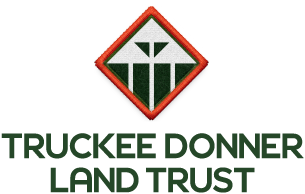The People of the Land Trust: John Hartog and Margaret Hand
John and Margaret knew they wanted to make a big impact to conservation in the Sierra. Thanks to their legal backgrounds in estate planning, they were able to personally create a gift in their own estate plans that will make a significant impact on the work of the Land Trust.
“When we decided to build the house in Truckee, we felt very strongly that we wanted to give something back to the community that we were going to try to make ours,” Margaret said. “We wanted to find something that was durable, that would last a long time, and that’s what attracted us to the Land Trust.”
John and Margaret have been in love with the Sierra Nevada for decades, skiing, hiking, and cycling throughout the region.
“We got a flyer from the Land Trust what must have been 30 years ago, and I’ve always liked the Land Trust model,” John said. “It always seemed the most reasonable, pragmatic approach to conservation.”
For John and Margaret, conservation in the northern Sierra is of great importance.
“When people go out into the wilderness, they have an experience of themselves they cannot have in man-made environments, even in a park,” Margaret said. “Once that’s gone, it’s gone.”
“So many people live close to the Sierra, and if we don’t preserve it, they, and their children and grandchildren, won’t be able to appreciate it,” John said.
With that desire in mind, John and Margaret picked the right tool for the job: a gift of remainder interests in their beautiful Truckee area home.
“We are the ideal donors for a gift like this: a new house, we have the resources to be generous with our children, and nieces and nephews, and we really care about the Sierra,” Margaret said.
“John and Margaret’s generosity will have an incredible impact on conservation in the northern Sierra, and on behalf of the Board and Staff of the Land Trust, we are truly grateful.” Said John Svahn, Executive Director of the Land Trust. “Gifts like these are so important to not only protecting open space, but caring for it for generations to come.”
And because John and Margaret are attorneys with estate planning experience, we’ll let them explain the charitable remainder concept:
Typically, a donor who makes a gift to charity but continues using the gift property cannot claim a charitable deduction for the gift. One of the few exceptions to this rule applies to gifts of remainder interests in a residence.
A remainder interest is, quite literally, what remains of a property after the death of the owner. When a donor gives away a remainder interest, the donor’s retained interest is called a “life estate.” When the donor dies, the charity becomes the owner of the property, by operation of law, so without probate.
The residence may be either the taxpayer’s principal residence or a vacation residence and the donor must own the property free and clear at the time of the gift. Additionally, the charity must qualify as a “public charity,” such as Truckee Donner Land Trust.
The value of the remainder, i.e. the value of the charitable deduction, is calculated according to several factors:
the age of the residence, also known as its remaining useful life,
the fair market value of the residence,
the age of the donor, and
the current “section 7520” interest rate. (The Internal Revenue Code section 7520 rate is used to discount to present value certain assets such as annuities, life estates, and remainder interests in real property. The rate is revised monthly by the IRS and is equal to 120% of the federal mid-term Applicable Federal Rate.)
The younger the house and the greater its fair market value, the larger will be the charitable deduction. Understandably, the older the donor, the greater the deduction.
Finally, higher prevailing interest rates diminish the value of the deduction. For example, if a 70-year-old gives to charity the remainder interest in a 15-year-old house with a value of $2,000,000, with a section 7520 rate of 4.6%, that taxpayer could claim an $800,000 income-tax charitable deduction. If the donors were a married couple, 70 and 65, their joint life expectancies would be used in the calculation, lengthening the duration of the life estate and lowering the charitable deduction to about $500,000.
After giving to charity a remainder interest, the donor remains responsible for the property and the charity has no right of entry. There are few limitations on what the donor may do with the property, but the donor may not mortgage it nor give the remainder interest to a different donee.
The Truckee Donner Land Trust is grateful to John Hartog and Margaret Hand both for their incredibly generous gift, and for their willingness to share their story and expertise for other Land Trust supporters.
To join John and Margaret in supporting the Land Trust, learn about other ways to give here.

